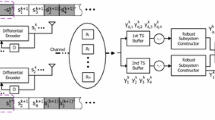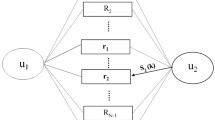Abstract
We consider cooperative networks of one source, four relays, and one destination. Each of them has a single antenna. The four relays use a proposed full rate distributed quasi orthogonal space time block code (DQOSTBC) scheme. If the channel state between the source and a relay is above a threshold, we select the elements of the DQOSTBC matrix to be the decode-and-forward (DAF) type; if it is below the threshold, the corresponding elements are the amplify-and-forward (AAF) type. Thus the proposed scheme is a DQOSTBC matrix with embedded adaptive DAF/AAF elements. The bit error rate (BER) simulation results show that the proposed DQOSTBC is approximately 7 dB better than the traditional DQOSTBC (all matrix elements are fixed as DAF type) at a BER of \(10^{-3}\) because traditional DQOSTBC loses full diversity due to errors in the information received. The proposed DQOSTBC is about 3 dB better than the rate 1/2 DOSTBC also proposed with adaptive DAF/AAF matrix elements at a BER of \(10^{-3}\) at the same spectral efficiency of 2 bits/s/Hz.




Similar content being viewed by others
References
Abdurahman, F., Elazreg, A., & Chambers, J. A. (2010). Distributed quasi-orthogonal space-time coding for two-way wireless relay networks. In Proceedings of 7th International Symposium on Wireless Communication Systems (ISWCS) (pp. 413–416). York, UK.
Alamouti, S. M. (1998). A simple transmit diversity technique for wireless communications. IEEE Journal on Selected Areas in Communications, 16(8), 1451–1458.
Dai, M., Sung, C. W., & Wang, Y. (2011). Distributed on-off power control for amplify-and-forward relays with orthogonal space-time block code. IEEE Transactions on Wireless Communications, 10(6), 1895–1903.
Das, S. & Ghosh, M. (2008). Implementation of full-diversity distributed STBC in cluster-based cooperative communication. In Proceedings of IEEE vehicular technology conference (VTC’08-Spring) (pp. 1216–1220), Singapore.
Gesbert, D., Shafi, M., Shiu, D., Smith, P. J., & Naguib, A. (2003). From theory to practice: An overview of MIMO space-time coded wireless systems. IEEE Journal on Selected Areas in Communications, 21(3), 281–302.
Jafarkhani, H. (2001). A quasi-orthogonal space-time block code. IEEE Transactions on Communications, 49(1), 1–4.
Jing, Y., & Jafarkhani, H. (2007). Using orthogonal and quasi-orthogonal designs in wireless relay networks. IEEE Transactions on Information Theory, 53(11), 4106–4118.
Laneman, J. N., & Wornell, G. W. (2003). Distributed space-time-coded protocols for exploiting cooperative diversity in wireless networks. IEEE Transactions on Information Theory, 49(10), 2415–2425.
Lei, Z., Yuen, C., & Chin, F. P. S. (2012). Quasi-orthogonal space-time block codes for two transmit antennas and three time slots. IEEE Transactions on Wireless Communications, 10(6), 1983–1991.
Liu, X., & Su, W. (2006). Optimum selection relaying protocols in cooperative wireless networks. In IEEE Global Telecommunications Conference (pp. 1–5).
Sung, C. W., Dai, M., & Hu, P. (2011). Achieving the outage capacity of the diamond relay network to within one bit and even less. IEEE Transactions on Vehicular Technology, 60(8), 4088–4093.
Tarokh, V., Jafarkhani, H., & Calderbank, A. R. (1999). Space-time block codes from orthogonal designs. IEEE Transactions on Information Theory, 45(5), 1456–1467.
Tseng, S.-M. (2009). Sequential detection for multiuser MIMO CDMA systems with single spreading code per user. IEEE Transactions on Wireless Communications, 8(7), 3492–3497.
Tseng, S.-M., Hsu, Y.-T., & Ren, S.-C. (2013). A distributed quasi-orthogonal space time block code for cooperative communication with information exchange errors for decode-and-forward relay networks. In Proceedings of the 2013 International Conference on Information Networking (ICOIN 2013) (pp. 286–290). Bankok, Thailand.
Wang, S.-H. (2011). Distributed quasi-orthogonal space time block code for four transmit antennas with information exchange error. M.Sc. Thesis, National Taipei University of Technology. Advisor: Shu-Ming Tseng.
Zhao, Y., & Chen, H. (2005). Design and performance analysis of quasi-orthogonal space-time block codes for four antennae. IEICE Transactions on Fundamentals, E88–A, 3244–3247.
Acknowledgments
This work was supported by the National Science Council of Taiwan under Grant NSC 101-2221-E-027-106. The system model is different in terms of number of source-relay-destination (4-1-1 in our ICOIN 2013 paper [14] v.s.1-4-1 in this paper). The system model in [14] has four independent single-antenna sources (multiple source/user), a single-antenna destination and a single-receive four-transmit antenna pure DAF relay node. And in this paper, the system model has one source node, one destination node and four relay nodes. There are all single-antenna nodes. In addition, this paper has performance analysis and [14] doesn’t. We also add simulation result with CRC [15] in Fig. 4, which [14] doesn’t have.
Author information
Authors and Affiliations
Corresponding author
Rights and permissions
About this article
Cite this article
Tseng, SM., Liao, CY. Distributed Orthogonal and Quasi-Orthogonal Space-Time Block Code with Embedded AAF/DAF Matrix Elements in Wireless Relay Networks with Four Relays. Wireless Pers Commun 75, 1187–1198 (2014). https://doi.org/10.1007/s11277-013-1415-2
Published:
Issue Date:
DOI: https://doi.org/10.1007/s11277-013-1415-2




